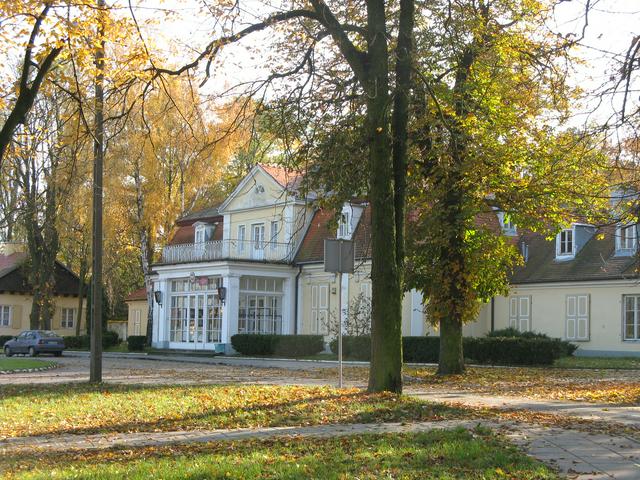
- Old Town – two markets connected to Królewska St. that after the modernization made along with Piłsudski square has become town's showcase, a place where Kutno citizens can spend their free time. Taking a walk around Old Town one can easily find marks of the medieval concept of Wolnośći square, church or Zduński fair (Zduńska St. and Tetralna St.). Current buildings at New Town and in Królewska St. have been constructed in the first half of the 19th century.
- Kutno Town Hall – currently place where Regional Museum is located
- Museum of the Battle of the Bzura river – at Wiosny Ludów park where grave chapel of Mniewscy family is located. It was built in the 19th century. Currently, the place where Museum of the Battle of the Bzura River is located
- Postal Palace – known also as the Saxon Palace that was used by king Augustus III on his travel way from Warsaw to Dresden. The building is one of the oldest in town; it was constructed in the 18th century. On 11 December 1812, Napoleon Bonaparte stayed there during his escape from Russia.
- Complex of Gierałty's palaces – property of the owners of Kutno. Currently seat of National Music School. Palace was constructed between 1781 and 1785 years. In 1920 Charles de Gaulle paid a visit there. Wiosny Ludów park is located behind the palace.
- Manor house of Chlewiccy (also called Modrzewiowy) with column-shaped veranda from the 1st half of 19th century – currently seat of the Companionship of Friends of The Kutno land.
- Manor house of Szymańscy – constructed in the first half of the 18th century. Currently it a hotel with restaurant.
- Izaak Holcman's villa by the Solidarność rotary. Currently a health center.
- Villa in the 8th Matejki St – constructed during the years 1927 to 1929 for the family of engineer Ryszard Macher
- "New Inn" building – formerly seat of the Provisional government on the first days of the January Uprising.
- Former St. Valenine hospital
- Lutheran church
- Dr Antoni Troczewski's Villa
- Complex of postfactory buildings of "Kraj" owned by Alfred Vaedtke
- Former city theatre at the Zduński Market (formerly House of Volunteer Fire Brigade)
- Motor mill in Warszawskie Przedmieście St.
- St. Lawrence Parish – founded in 1301. The first reference about St. Lawrence the Martyr comes from 1301 and mentions parish priest Michał. The first presumed wooden construction of the church was in the 13th century during the efforts to construct village parishes. It was a small church made in a Gothic style that had lasted until 1483 when burned down. The new one was funded by the Mikołaj from Kutno in 1484. It was made in gothic style, a one-aisled church with set apart presbytery and tower on the west side and St.Anne chapel adjacent to the aisle. In 1883 because of high-level of damage church had been decided to be pulled down. Construction of the current one ended in 1886 according to a design made by Konstantyn Wojciechowski. Basilical, neo-gothic church has two towers with clock placed on the top of one.
- St. John the Baptist Parish – founded in 1988. The main altar consists of a relief depicting Resurrected Christ, Consecration by Pope John Paul II in Łowicz on 1 June 1999.
- The Saint Queen Jadwiga Parish – founded in 1990. On 8 June 1997 on Kraków grasslands Pope John Paul II Consecration Cornerstone for the construction of this church.
- St. Stanislaus the Martyr Bishop Parish – founded in 1297
- The Our Lady of Perpetual Help Parish church – founded in 1988
- Saint Michael the Archangel Parish – is placed in Woźniaków district.
- Wiosny Ludów park – is the oldest and simultaneously biggest park in Kutno (area 17,1ha). Once it was a palace garden by the Gierałty's Palace and came into being during the years 1775 to 1791. Park is separated in two parts, first one is a symmetric garden that is similar to the shape of French garden. The other one is landscape English garden, which came into being during the years 1826 to 1840. In the western edge of the park stands chapel in the memory of Mniewscy family (owners of Kutno from the 19th century).
- Romuald Traugutt city park – placed in the central part of town on the area of 4,2ha. Has been founded during Poland's twenty years of independence after World War I as a place where one can reSt. Park is placed on terrain with diverse heights which gives him interesting landscape composition with pond being placed on the lowest part. At first, it was just an industrial pond nowadays it is adapted to leisure functions. Most of the cultural events in Kutno take place there. Stefan Żeromski's public library and Kutno House of Culture are placed in there.
- City park by the Ochnia river – is the newest park in Kutno. Groundworks ended there in 2003 year. Park's small woodiness gives it a modern image. Football and Basketball pitches located in the neighborhood create opportunity to practice sports.
